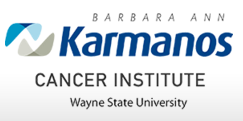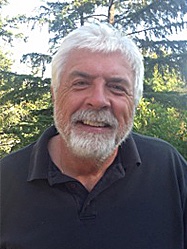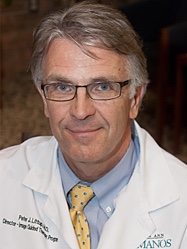 Laura Ross-Paul of Portland, Oregon, calls herself a “patient pioneer,” as one of the first women in the world to receive cryoablation as the primary treatment for her multi-focused breast cancer 13 years ago.
Laura Ross-Paul of Portland, Oregon, calls herself a “patient pioneer,” as one of the first women in the world to receive cryoablation as the primary treatment for her multi-focused breast cancer 13 years ago.
Cryotherapy, also called cryosurgery, cryoablation or targeted cryoablation therapy, is a minimally invasive procedure that uses the application of extremely cold temperatures (cryo) to destroy diseased tissue (ablation), including cancer cells.
For internal tumors, cryotherapy is carried out by using a cryoprobe — a thin hollow wand-like device with a handle or trigger or a series of small needles, attached via tubing to a source of nitrogen or argon, which super-cools the probe tip through which cooled, thermally conductive fluids are circulated. Cryoprobes are inserted into or placed adjacent to diseased tissue in a way that ablation will provide correction, yielding benefit to the patient.
The cryoprobe is placed in the proper position using imaging guidance, and as internal tissue is being frozen, the physician avoids damaging healthy tissue by viewing movement of the probe on ultrasound, computed tomography (CT) or magnetic resonance (MRI) images transmitted to a video monitor. With the probes in place, the cryogenic freezing unit removes heat from the tip of the probe and by extension from surrounding tissues.
Ablation occurs in tissue that has been frozen by at least three mechanisms:
• Formation of ice crystals within cells, thereby disrupting membranes and interrupting cellular metabolism among other processes;
• Coagulation of blood thereby, interrupting blood flow to the tissue, in turn causing ischemia and cell death;
• Induction of the so-called programmed cell death cascade.
 Ross-Paul received her cryotherapy treatment in 2003 at the Karmanos Cancer Center in midtown Detroit, Michigan,
Ross-Paul received her cryotherapy treatment in 2003 at the Karmanos Cancer Center in midtown Detroit, Michigan,  one of 41 National Cancer Institute-designated Comprehensive Cancer Centers in the U.S. and the only hospital in Michigan dedicated exclusively to fighting cancer.
one of 41 National Cancer Institute-designated Comprehensive Cancer Centers in the U.S. and the only hospital in Michigan dedicated exclusively to fighting cancer.
With continuing improvement of imaging techniques and development of devices that can more precisely control the topical application of extreme temperatures to better control extreme temperatures, Karmanos Cancer Center physicians use cryotherapy as a treatment for patients with skin tumors, precancerous skin moles, nodules, skin tags, or unsightly freckles. They can also use cryotherapy to treat patients with benign and malignant breast tumors, although cryotherapy to treat malignant breast tumors is still considered experimental, and certain other cancers, including cancers of the prostate, liver (usually metastasized from other organs), cervix, and fibroadenoma.
Cryotherapy Benefits
Compared with other techniques, one of the benefits of cryotherapy includes minimal pain, minimal scarring, lower cost, and faster recovery times. The Karmanos Cancer Center, which is affiliated with Wayne State University’s School of Medicine, explains that once diseased cells are destroyed, components of the immune system clear out the dead tissue, and that patients undergoing cryosurgery usually experience minor to moderate localized pain and redness, which can be alleviated by over the counter painkillers such as aspirin or ibuprofen, and application of topical steroid creams.
Blisters may form, but they usually scab over and peel away. As with any medical treatment, there are risks involved, primarily damage to nearby healthy tissue and the potential for not thoroughly freezing the entire tumor during treatment. Damage to nerve tissue is also of particular concern.
Now a cryotherapy activist and advocate, Ross-Paul says that while to date there have been several dozen patients treated by cryoablation for breast tumors by Dr. Peter Littrup, a pioneer in the cryotherapy field, the Chinese, who began using cryoablation to treat breast cancer about the same time as Littrup, have treated more than 3,800 women using the method.
“Disturbing”
“The fact that these tremendous advances in China have not been duplicated in the U.S. is disturbing,” Ross-Paul said. “As activists promoting cryoablation in America, I and my husband have tried to identify why the progress in America is so slow, and then conceive of a solution to this problem. We believe we have the answer.”
Ross-Paul contends that “in America, cryoablation is seen as a treatment that needs to be proven effective before it is considered a safe alternative to the mastectomy and lumpectomy. FDA trials have been undertaken in the last 13 years, but the size of the trials have been limited due to financial constraints. As a result, when a doctor advises their patient who has breast cancer, cryoablation is considered as an unproven, experimental alternative to the much safer and statistically proven surgery.”
“Without statistical proof through trials,” she said, “cryoablation wont be used. But if cryoablation isn’t used, there will be no statistics. This has doomed cryoablation in the U.S. to forever be an experimental treatment. To get around this dilemma, we believe that prevention is the key. Through early detection, women are finding something suspicious in a mammogram. Since it is not yet identified as cancer, they are told to wait and see if it develops. If it doesn’t, after a long time of fearful waiting, there is a joyful sigh of relief. If it is cancer, however, at that point, cryoablation is not considered and only surgery is advised.”
What Women Want
But “women don’t want to just wait and do nothing,” Ross-Paul said. “In this six month wait-and-see period they are ready for action. The solution is to develop a new protocol that accompanies early detection, and that would be to use cryoablation to freeze anything suspicious. Why wait for something to manifest as a tumor? Why not keep the patients’ safety uppermost in mind and ablate the unusual tissue, and then follow up with more imaging? Cryoablation can’t hurt the breast, it is almost painless and very inexpensive. And if something suspicious returns, use cryoablation again until the condition either goes away, or becomes an obvious tumor which can then be treated by cryoablation, or by surgery.”
Ross-Paul maintains that if this new protocol is used in enough patients, the power of the naturally occurring immune effect will start to show itself, noting that “each time something suspicious is frozen and it was actually breast cancer, then about half those cases will be put into remission. Over time, a statistical base will demonstrate that women treated through early, preventative cryoablation develop far less breast cancer than those who simply wait, if they continue to engage in early detection combined with cryoablation.”
“There is no need to prove that cryoablation is superior to or as effective as surgery,” Ross-Paul said, “although efforts to do so can and should continue on a separate track. It can prove itself through this new protocol by eventually reducing the incidence of breast cancer almost entirely. This is what women need. This is what women want.”
 Ross-Paul has co-written a book with her husband, Alex Paul, and her cancer physician, Dr. Peter Littrup, titled “They’re Mine and I’m Keeping Them,” which documents the story of how she and her husband bucked the system and found Littrup, whose
Ross-Paul has co-written a book with her husband, Alex Paul, and her cancer physician, Dr. Peter Littrup, titled “They’re Mine and I’m Keeping Them,” which documents the story of how she and her husband bucked the system and found Littrup, whose  advanced skill in the field of cryo-ablation ultimately saved her breast. The co-authors also relate the success at Fuda Hospital in Guangzhou, China in treating a variety of Stage 4 cancers by combining cryoablation and advanced immune system therapies, which increase the frequency of the occurrence of the natural immune effect to approximately 80 percent or higher of the cases.
advanced skill in the field of cryo-ablation ultimately saved her breast. The co-authors also relate the success at Fuda Hospital in Guangzhou, China in treating a variety of Stage 4 cancers by combining cryoablation and advanced immune system therapies, which increase the frequency of the occurrence of the natural immune effect to approximately 80 percent or higher of the cases.
“They’re Mine and I’m Keeping Them” is available from Amazon.com in both hard copy and ebook (Kindle) versions. Ross-Paul also maintains a Web page: http://keepingthem.com and a Facebook site: http://Facebook.com/keepingthem.
Through her several avenues of outreach, Ross-Paul says she has helped a handful of women receive cryoablation treatment by Littrup, and “has learned that women need a cure for cancer, and they want that cure to not involve losing their breast through a mastectomy or disfiguring it with a lumpectomy.”
She said that “while a cure for breast cancer might someday achieve these goals through the simple action of taking a pill, that day has not yet come,” and that “in the meantime, cryoablation can put breast cancer in remission, giving women what they need, and not disfigur[ing] a woman’s breast, thus giving women what they want.”
“The beauty of cryoablation,” Ross-Paul said, “is that it is breast conserving — I was able to avoid a mastectomy,” its low morbidity — “I never needed more than a Tylenol,” and its inexpensive cost compared to surgery. Ross-Paul says another major benefit of cryoablation is that in about half of all cases, “cryoablation naturally stimulates the body’s immune system to develop an immunity to the cancer as it eats up the now-dead tumors.”
Ross-Paul has recently been asked to speak at the 5th International Forum on Cancer Treatment to be held July 1-3 in Guangzhou, China, which will be her second speaking engagement at this forum. The focus of the 2016 forum will be on treatment of cancer by cryosurgery, irreversible electroporation (IRE), immunotherapy, and stem cell treatment for cancer.
The forum is organized by the International Society of Cryosurgery and Asian Society of Cryosurgery, Fuda Cancer Hospital, Jinan University School of Medicine, and the First Affiliated Hospital of Shenzhen University. The organizers have invited experts and peers from around the world, including America, the U.K., Japan, Australia, and other authorities.
“I appreciate the forum organizing committee’s inclusion of a patient pioneer to speak alongside the doctors and researchers,” Ross-Paul said.

